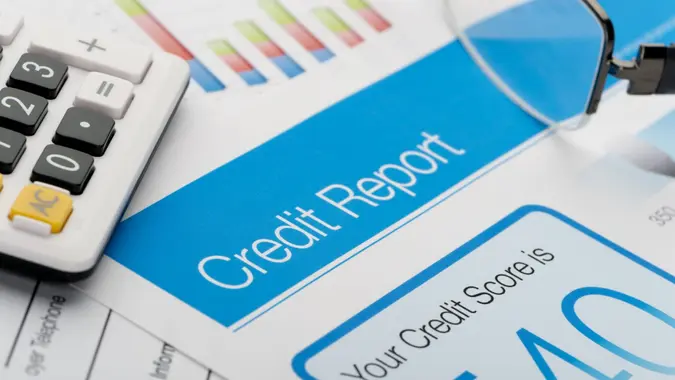Top 6 Ways To Boost Your Credit Score Before Refinancing

Commitment to Our Readers
GOBankingRates' editorial team is committed to bringing you unbiased reviews and information. We use data-driven methodologies to evaluate financial products and services - our reviews and ratings are not influenced by advertisers. You can read more about our editorial guidelines and our products and services review methodology.

20 Years
Helping You Live Richer

Reviewed
by Experts

Trusted by
Millions of Readers
Is it time to refinance your mortgage, your car loan or student loans? To get the best interest rate, you’ll need to have the best credit score. And getting the best rate is especially important now that rates are considerably higher than they were a year or two ago.
Here are six ways you can improve your credit score before you refinance.
Pay On Time
Paying your bills on time goes a long way toward increasing your credit score. In fact, 35% of your credit score is based on your payment history. Unfortunately, this is the one factor that is most difficult to improve quickly, since it relies on historical data.
Since you can’t start any sooner than today, make sure you make all of your payments on time from this day forward. The best way to do this is to put all of your accounts on autopay, so you don’t risk forgetting to make a payment. Make sure your payment is made a few days in advance of the due date, since lenders can vary in the amount of time they take to post a payment.
Reduce the Amount You Owe
Paying down existing debt is a great way to improve your credit score quickly. Credit utilization (the amount of credit you have available to you that you are actually using) accounts for about 30% of your FICO score.
Here’s how it works. If you have two credit cards, each with a credit limit of $10,000, you have $20,000 of available credit. If you have no balance on one card, and a $2,000 balance on the other, you are using 10% of the credit that is available to you, or a credit utilization ratio of 10%. This is excellent, and the credit bureaus look very favorably on this.
If, however, you have maxed out one of your cards, and have a balance of $5,000 on the other, for a total outstanding debt of $15,000, you are using 75% of the credit available to you. In other words, your credit utilization is 75%. This is high, compared to 10%, so reducing the balance you carry over on your cards can help improve your credit utilization ratio, thereby boosting your credit score.
Paying down high-interest credit card balances has lots of benefits, and improving your credit utilization ratio is just one of them. By paying these cards down — or better yet, off — you will also improve your debt-to-income ratio, which lenders look at when evaluating your loan application. You’ll also free up extra cash that had been going to those high interest rates.
Increase Your Credit Lines
If you don’t have the cash on hand to pay down your credit cards, try requesting a credit line increase. Using the example above, if you increased your credit limit on one of your cards to $15,000, you are now using $15,000 out of $25,000 of available credit, which is credit utilization rate of 60% rather than the previous 75%. Instant boost to your credit score! Don’t open a new account to do this, however, because that impacts your score in a different way, as you’ll see below.
Don’t Close Old Accounts
Closing accounts you no longer use may seem like a good way to “clean up” your credit report, but don’t do it. You’ll reduce your available credit, which will negatively impact your credit utilization rate. Leave them open, but don’t use them.
Another part of your FICO score is your credit history, which can account for 15% of your score. So if you’ve had those accounts for a long time, it’s doubly important to keep them open. Lenders don’t want to see borrowers who open and close accounts willy nilly, so maintain your old accounts, even if you don’t use them.
Don’t Open Any New Accounts
Your credit score takes a hit every time a lender inquires about your credit, which they do when you submit an application for a credit card, store financing or another loan. So, wait on getting that new furniture that offers “no payments until the twelfth of never” or that travel credit card with a gazillion bonus points, until after your refinance is complete. And remember that a “hard” credit inquiry, which some lenders will do when you first fill out the application, will stay on your credit report for up to two years. New credit accounts for about 10% of your FICO score.
Understand What Kind of Credit You Have
There are two types of credit: revolving credit and installment loans. Revolving credit is credit with a fixed (or indeterminate) credit limit, and once you pay down your balance, you can charge more. Credit cards fall into this category. Suppose you have a credit card with a $10,000 limit. You charge $5,000 worth of stuff, so you now have $5,000 of available credit. You pay off the $5,000 balance, and you can now use the credit card for up to $10,000 in purchases again. That’s the “revolving” part.
The other kind of credit is installment loans. Student loans and car loans fall into this category. You get a loan of a certain amount, and you make monthly payments on it. You can’t borrow more than the initial amount, and once you’ve made all the payments, the loan is paid off and the account is closed. Note that installment loans don’t typically count toward your credit utilization ratio, since there’s no available credit even as you pay them down. So you won’t be penalized on your credit score by paying off an installment loan.
Your credit mix, or the relative amounts of revolving and installment loans, is responsible for about 10% of your credit score. You should have some of both kinds of credit, but if you don’t, leave it alone. Any score improvement you’d get by opening new accounts to adjust your credit mix would be offset by the negative impact of new applications.
Improving your credit score significantly doesn’t happen overnight, but by being aware of the factors that impact your score and working diligently toward it, a better score could be in your future.
More From GOBankingRates
 Written by
Written by  Edited by
Edited by 






















